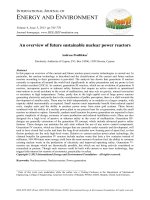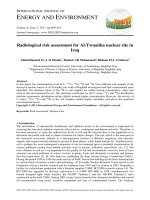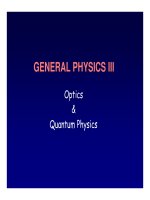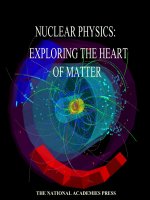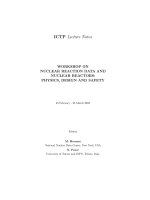Nuclear physics
Bạn đang xem bản rút gọn của tài liệu. Xem và tải ngay bản đầy đủ của tài liệu tại đây (4.27 MB, 21 trang )
Nuclear Physics
Properties of Nuclei
Binding Energy
Radioactivity
Nuclear Components
•
•
•
•
•
•
Nucleus contains nucleons: protons and neutrons
Atomic number Z = number of protons
Neutron number N = number of neutrons
Mass number A = number of nucleons = Z + N
Each element has unique Z value
Isotopes of element have same Z, but different N
and A values
Notation:
A
Z
X
Nucleus Charge and Mass
Particle
Charge
Mass (kg)
Mass (u)
Mass (MeV/c2)
Proton
+e
1.672 6 E−27
1.007 276
938.28
Neutron
0
1.675 0 E−27
1.008 665
939.57
Electron
−e
9.109 E−31
5.486 E−4
0.511
• Unified mass unit, u, defined using Carbon 12
• Mass of 1 atom of 12C ≡ 12 u
1 u = 1.660 559 ×10
−27
kg = 931.494 MeV c
2
Nuclei Sizes
• Scattering experiments
determine size
• Measured in femtometers
(aka fermis)
• All nuclei have nearly the
same density
Fig. 29.2, p. 959
r = r0 A
13
1 fm ≡ 10 −15 m
[ 29.1]
Nuclear Stability
• An attractive nuclear
force must balance the
repulsive electric force
• Called the strong
nuclear force
• Neutrons and protons
affected by the strong
nuclear force
• 260 stable nuclei
• If Z > 83, not stable
Fig. 29.3, p. 960
Binding Energy
• Total energy of
nucleus is less than
combined energy of
individual nucleons
• Difference is called
the binding energy
(aka mass defect)
• Energy required to
separate nucleus
into its constituents
∆m = ( ∑ mi ) − m A
Binding Energy vs. Mass Number
Fig. 29.4, p. 961
Radioactivity
• Unstable nuclei decay to more stable nuclei
• Can emit 3 types of radiation in the process
α particles : He nuclei
4
2
β particles : e − or e +
γ rays : high energy photons
A positron (e+) is the antiparticle
of the electron (e−)
Fig. 29.5, p. 962
Decay Constant and Half-Life
• Decay rate (aka activity) is number of
decays per second
• λ is the decay constant
• Unit is Curie (Ci) or Becquerel (Bq)
• Decay is exponential
• Half-life is time it takes for half of the
sample to decay
1 Ci ≡ 3.7 ×1010 decays s 1 Bq = 1 decay s
∆N
R=
= λN
∆t
[ 29.3]
N = N 0 e − λt
ln 2 0.693
T1 2 =
=
λ
λ
[ 29.5]
[ 29.4a ]
Fig. 29.6, p. 919
Alpha Decay
• Unstable nucleus emits
α particle (i.e., a helium
nucleus) spontaneously
• Mass of parent is greater
than mass of daughter
plus α particle
• Most of KE carried away
by α particle
A
Z
X→
Fig 29.7, p. 966
A− 4
Z −2
Y + He
4
2
[ 29.8]
Beta Decay
• Involves conversion of proton to
neutron or vice-versa
• Involves the weak nuclear force
• KE carried away by
electron/antineutrino or
positron/neutrino pair
• Neutrinos: q = 0, m < 1 eV/c2, spin
½, very weak interaction with
matter
n → p + e +ν
A
Z
X→
p → 01n + e + + ν
A
Z
X → Z −A1Y + e + + ν
1
0
1
1
Fig. 29.8a, p. 968
1
1
−
A
Z +1
Y + e +ν
−
[ 29.11]
[ 29.12]
Gamma (γ) Decay
• Following radioactive decay, nucleus may be left
in an excited state
• Undergoes nuclear de-excitation:
protons/neutrons move to lower energy level
• Nucleus emits high energy photons (γ rays)
• No change in A or Z results
12
5
B → 126C* + e − + ν
12
6
C* → 126C + γ
Radioactive
Carbon Dating
• Cosmic rays create 14C
from 14N
• Constant ratio of 14C/ 12C
(1.3×10–12) in atmosphere
• Living organisms have
same ratio
• Dead organisms do not (no
longer absorb C)
• T½ of 14C = 5730 yr
• Measure decay rates, R
R = R0 e
− λt
ln ( R R0 )
⇒t =−
λ
Natural Radioactivity
• Three series of naturally occurring
radioactivity
•
232
238
Thorium Series
235
Th more plentiful than U or U
• Nuclear power plants use enriched
uranium
• Other series artificially produced
Fig. 29.10, p. 971
Nuclear Reactions
• Accelerators can
• Atomic and mass
generate particle
numbers (Z and A) must
energies up to 1 TeV
remain balanced
• Bombard a nucleus with • Mass difference before
energetic particles
and after reaction
determines Q value
• Nucleus captures the
– Exothermic: Q > 0
particle
– Endothermic: Q < 0
• Result is fission or fusion
• Endothermic requires
incoming particle to have
KEmin
Fusion and Fission
Interaction of Radiation with Matter
• Radioactive emissions can ionize atoms
• Problems occur when these ions (e.g.,
OH−, H+) react chemically with other ions
• Genetic damage affects reproductive cells
• Somatic damage affects other cells
(lesions, cataracts, cancer, fibrosis, etc.)
Quantifying Radioactivity
Quantity
Definition
SI unit
Common Unit
Activity
# nuclei that
decay per sec
1 Bq ≡ 1 decay/s 1 Ci = 3.70×1010 Bq
Exposure (defined
for X and γ rays
only)
1 R ≡ amount of
radiation that
Roentgen (R)
Ionization per kg
produces
2.58×10−4 C/kg
Absorbed Dose (D)
1 Gray (Gy)
Energy
absorbed per kg
≡ 1 J/kg
1 rad = 10−2 Gy
Relative Biological
How much more damage is done compared to X or γ
Effectiveness (RBE) rays of equivalent energy (unitless).
Damage
Dose Equivalent (H)
expected
1 Sv
≡ 1 RBE×Gy
1 rem = 10−2 Sv
RBE Factors
Radiation Type
X and γ rays
RBE Factor
1.0
β particles
1.0−1.7
α particles
10−20
Slow n
4−5
Fast n and p
10
Heavy ions
20
Table 29.3, p. 974
Sources of Ionizing Radiation
From Touger, Introductory Physics, Table 28-4, p. 817
Typical Dose Equivalents
From Touger, Introductory Physics, Table 28-4, p. 817
Exercise
• Is the dose equivalent greater if you are exposed
to a 100 mrad dose of α particles or a 300 mrad
dose of β particles?
α particles:
β particles:
H min = (10 )(100 mrad ) = 1 rem
H max = ( 20 )( 300 mrad ) = 6 rem
H min = (1)(100 mrad ) = 0.1 rem
H max = (1.7 )( 300 mrad ) = 0.51 rem
α particles are more effective at delivering a dose, but do
not penetrate as far as β particles



